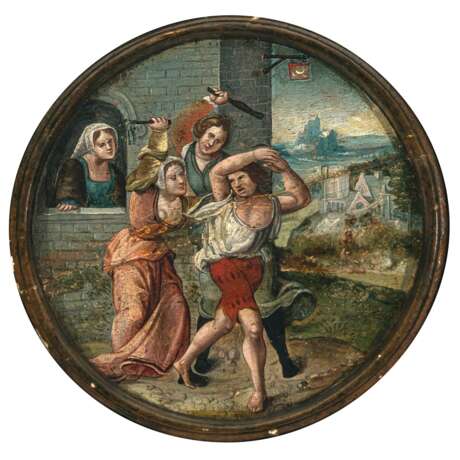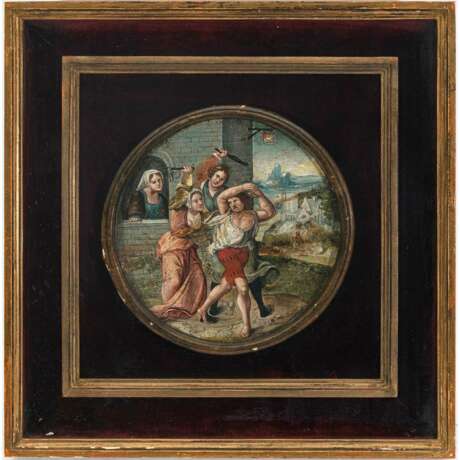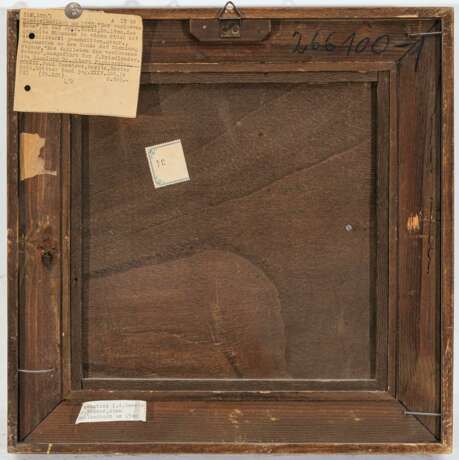ID 1237506
Lot 130 | Antwerpen 2nd third of the 16th century
Estimate value
€ 2 000 – 3 000
Inscribed "Hassan" on an adhesive label verso. Adhesive labels with numbers 10 / 34 and handwritten numbering 266100-1 on the frame verso. Oil auf panel. Plate bent. Restored. Damaged.
additional: Machine-written note with the transcription of an older catalogue text "266.100/1 (...) A IX 68 [...]"
Auf dem maschinenschriftlichen Zettel wird Bezug genommen auf die Darstellung "Der verlorene Sohn", prassend bei Dirnen, der als Kat.-Nr. 54 in der Auktion der Sammlung Albert Figdor angeboten wurde (Öl auf Holz, D. 20 cm). Vorliegender "Tondo" wird als Gegenstück zu diesem Objekt bezeichnet.
Die kleine Rundform für eine bildliche Darstellung war v. a. im 16. Jahrhundert sehr beliebt. Eine besondere Gruppe unter diesen Rundbildern stellen Holzteller dar, deren Spiegel mit einer figürlichen Szene bemalt war, oft finden sich auf dem Tellerrand erläuternde Inschriften. In der Antwerpener Lukasgilde wurden Künstler geführt, die als "teljoorschilder" (Teller-Maler) benannt wurden. Um ein Werk eines solchien Teljoorschilders handelt es sich auch bei dem vorliegenden Objekt.
In der Literatur wird ausführlich über Tellerserien berichtet, deren Spiegel Szenen aus dem Gleichnis vom Verlorenen Sohn schmücken. "Kein Gleichnis gibt dem Darsteller zu mehr Phantasie Anlaß, keines ist weniger epoche- und landgebunden, keines in gleicher Weise immer aufs neue aktuell, keines schont mehr den Fehltritt. Wie leicht macht dieses Christuswort die Reue, um wieviel leichter noch Vergebung zu erhalten [...] Uns macht es Vergnügen, den Zuchtlosen von den Huren hinausgeworfen zu sehen, in Hemd und Hosen [...] (De Coo, s. u., S.94).
Als Vorbild für die vorliegende Komposition lassen sich im niederländisch-flämischen Kunstkreis einige Vergleichsobjekte heranziehen, so eine Zeichnung des Jan Swart van Groningen im Herzog Anton Ulrich-Museum, Braunschweig, und ein Holzschnitt des Cornelis Anthonisz. Am interessantesten ist für einen Vergleich aber ein Folge von Holztellern im Antwerpener Volskundemuseum (Inv.-Nr. 72511-72518). Diese Teller (mit Durchmessern von je ca. 19 cm) sind u. a. mit Darstellungen aus dem Gleichnis vom Verlorenen Sohn dekoriert. Besonders erwähnenswert ist der Teller mit der Darstellung des im Wirtshaus Prassenden (Inv.-Nr. 72513), kompositionell engstens verwandt mit dem 1930 versteigerten Teller der Sammlung Figdor. Zur Antwerpener Serie gehört auch ein Teller mit der Vertreibung des Verlorenen Sohnes aus dem Wirtshaus. Die Vorlagen für die Darstellungen finden sich bei Pieter Cornelisz. Kunst. Dieser war ein Leidener Glasmaler und Zeichner von Kabinettscheiben. Die Vorlage für unsere "Vertreibung des Verlorenen Sohnes" ist jedoch noch unbekannt.
Nur noch wenige der in Antwerpen in der Zeit um 1520/30 produzierten und mit Gemälden geschmückten Teller sind erhalten. Vgl. hierzu De Coo, Jozef, "Die bemalten Holzteller, Bekannte und Neutentdeckte - Ihr Schmuck und seine Herkunft", in: Wallraf-Richartz Jahrbuch. Bd. 37 (1975), S. 85-118, hier besonders S. 92 ff.: zu den erwähnten Tellern des Antwerpener Volkskundemuseums.
Cf. "Die Sammlung Albert Figdor - Wien. Erster Teil", volume 3. Berlin [Paul Cassierer - Artaria & Co. - Glückselig Gmbh], 29-30 September 1930, page XXXIV f., catalogue number 54 (with illustration): the almost identically sized plate from the Figdor collection.
Provenance: Collection of Dr. Albert Figdor Vienna - Owned by the family ever since.
| Auction house category: | Paintings 15th -18th century |
|---|
| Auction house category: | Paintings 15th -18th century |
|---|
| Address of auction |
Kunstauktionshaus Neumeister Barer Str. 37 80799 München Germany | ||||||||||||||
|---|---|---|---|---|---|---|---|---|---|---|---|---|---|---|---|
| Preview | |||||||||||||||
| Phone | 089 231710-20 | ||||||||||||||
| Fax | 089 231710-50 | ||||||||||||||
| Buyer Premium | 30% | ||||||||||||||
| Conditions of purchase | Conditions of purchase | ||||||||||||||
| Business hours | Business hours
|





